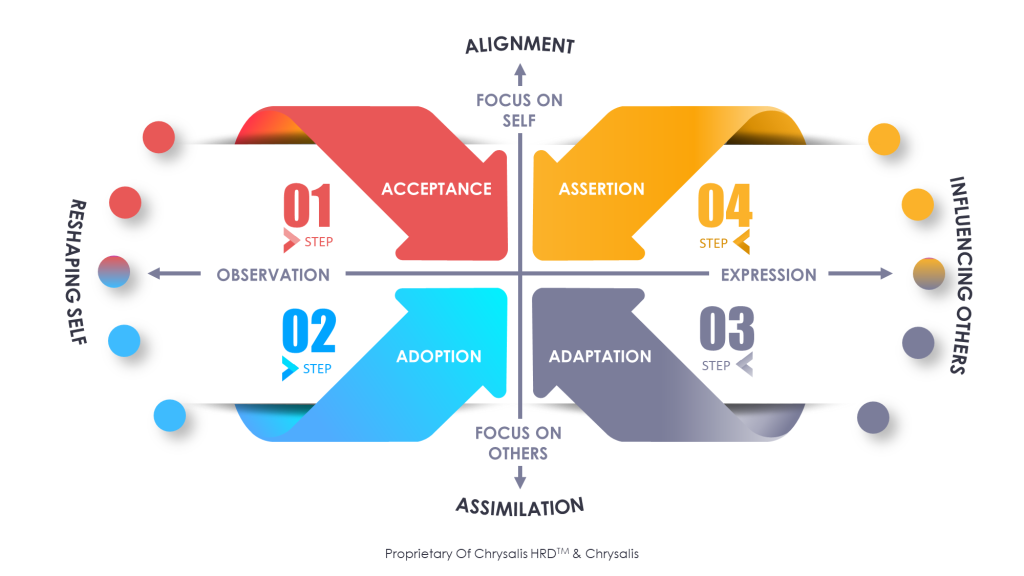Today is the first anniversary of when our daughter-in-law stepped into our home.
Becoming a part of a new family is perhaps the most daunting thing ever. It was like becoming a part of a new team and knowing that there were very few options to leave the team.
My daughter-in-law was someone I had known for over 4 years before my son very wisely married her. But seeing her ease into a new house, adding to an existing home, and fostering new relationships showed me sides to her that I cannot but admire.
Watching her helped me glean insights on what accelerates absorption of a new team member into an existing team.

When we step into a new team, like she did, there are two sets of polarities that come into play. On the X- axis is the lens of communication – which is observation at one end and expression at the other. On the Y-axis is the engagement focus which has focus on self at one end and focus on others at the other end.
The interplay of these four provides a balance of how a new team member can ease into an existing team.
In the span of the last one year, I saw my daughter-in-law use these polarities and everything in between to establish four behaviour patterns which work to accelerate absorption.
Step 1 – Acceptance
She focused on herself and observed to accept the differences of the new team (in this case, our family). There were many differences between the home she left behind to one she stepped into. She came from a home that was bustling with people into a home which was guarded and very private. She came into a home where mealtime conversation was about politics and current affairs. There was a dizzying preoccupation with work and careers. Our daughter-in-law focused on grounding herself and observed and accepted. This was an acceptance of the differences that came with no judgements or rancour or a sense of loss.
Acceptance in a work team is about taking in the differences and just staying with it. It is about realising that the situation you are in, is a result of your own free will. Staying noncritical of self and just observing non-judgementally makes for an easier absorption.

Step 2 – Adoption
Over time, she started focussing on the nuances of the others viz. the Singla family and observed to understand the nuances of how we functioned. She understood our need to organize and be organized, get things a 100% right irrespective of what was being done, the complete unimportance of meals and a million other idiosyncrasies. She adopted what she could easily adopt and that which would add value to her. There were no hard and fast rules about pressure of adoption. What did not work for her, she just ignored without whinging and whining.
In work teams, with the passage of time, maybe weeks or months, it becomes helpful to adopt from the work culture that you have become a part of. Obviously, not everything lends itself to being adopted or is easy to adopt. The crux is to pick what truly adds value to you, to make you a stronger contributing team member.

Step 3 – Adaptation
As my daughter-in-law started feeling more comfortable in her new team environment, she continued to focus on others and the communication evolved from just observation to expression. She put into action her own ways of building on what was already existing – changing things without causing distress. Adding value through her adaptation made the family seek out more of her and what she brought to the table. She started putting her touch into engagements, conversations, activities and built new traditions on the back of the old ones. She brought her differences to her new home and added to the culture.
As a new team member in an existing work team, adaptation helps create paths of least resistance while setting the stage for changes that you may want to bring about. A lot of us make the mistake of rushing in with a litany of changes that we would like to make in the teams we join. If adaptation takes place, rather than drastic change, it creates an environment of value and collaboration.

Step 4 – Assertion
My daughter-in-law never pretended to be anything than her authentic self. She was unapologetically herself. She took pride in the way she had been brought up (and she had every reason to be proud). She owned her failures with her head held high as much as she was nonchalant about her successes. This quiet assertion, that she displayed through a strong focus on who she is and the ability to express what was really important to her, made her carve her own place in the family. She did this in a caring and contributing manner. She was no longer the new entrant in the family – she had craved out her own equations with everyone. The house help doted on her, the extended family who welcomed her as one of their own, family friends who smiled when they spoke about her – she had established herself as a true team member, and she had done this with authenticity and care.
At the workplace, bringing your most authentic self to the team and showing genuine care for the team and intentionally contributing to the team’s success makes the journey from a newbie to a valued team member positive and productive.

It is important to understand that when you are Accepting (Step 1) and Adopting (Step 2), you are reshaping yourself to fit into the new team and when you are Adapting (Step 3) and Asserting (Step 4), you are influencing others to accept you for who you are.
When you are Accepting and Asserting – there is a high degree of Alignment that is taking place. In Accepting, you are aligning to the team and when you are Asserting, you are nudging the team to align to you.
When you are Adopting or Adapting – there is a high degree of Assimilation that is taking place. In Adopting, you are assimilating into the team and when you are Adapting, you are encouraging the team to assimilate into your way of being.
Relationships, whether at work or at home, are always complex and need to be worked on with the long-term view in mind. Working through Steps 1 to 4 may take time but the footing you had is strong and well thought of. These steps create strong two-way alignment and assimilation and build long term trust and belief in each other.
I have always believed that the best lessons lie in the most unexpected of places and situations. Being an entrepreneur, I have not been the newbie in any team for a long time now. I have always believed that the organisation has to work hard to ensure that new people feel welcome, and it is the responsibility of the organisation to align people and assimilate them. This was the first time that I saw how self-empowerment gives the new team member the agency to create an environment where they can truly become an integral part of any team.
In the last one year, this lesson from my daughter-in-law has been invaluable in developing a new perspective. Thank you, Nikita, for adding value to my life in more ways than one.


